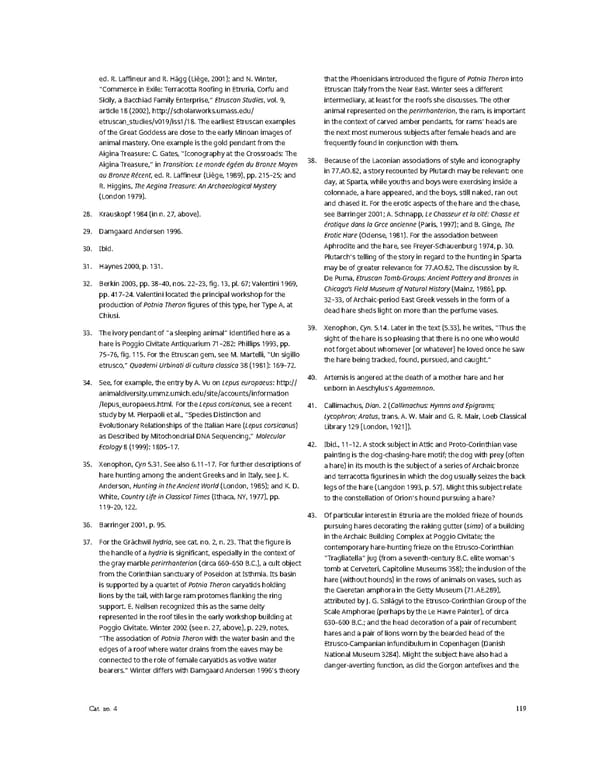ed. R. Laffineur and R. Hägg (Liège, 2001); and N. Winter, that the Phoenicians introduced the figure of Potnia Theron into “Commerce in Exile: Terracotta Roofing in Etruria, Corfu and Etruscan Italy from the Near East. Winter sees a different Sicily, a Bacchiad Family Enterprise,” Etruscan Studies, vol. 9, intermediary, at least for the roofs she discusses. The other article 18 (2002), http://scholarworks.umass.edu/ animal represented on the perirrhanterion, the ram, is important etruscan_studies/v019/iss1/18. The earliest Etruscan examples in the context of carved amber pendants, for rams’ heads are of the Great Goddess are close to the early Minoan images of the next most numerous subjects after female heads and are animal mastery. One example is the gold pendant from the frequently found in conjunction with them. Aigina Treasure: C. Gates, “Iconography at the Crossroads: The 38. Because of the Laconian associations of style and iconography Aigina Treasure,” in Transition: Le monde égéen du Bronze Moyen in 77.AO.82, a story recounted by Plutarch may be relevant: one au Bronze Récent, ed. R. Laffineur (Liège, 1989), pp. 215–25; and day, at Sparta, while youths and boys were exercising inside a R. Higgins, The Aegina Treasure: An Archaeological Mystery colonnade, a hare appeared, and the boys, still naked, ran out (London 1979). and chased it. For the erotic aspects of the hare and the chase, 28. Krauskopf 1984 (in n. 27, above). seeBarringer 2001; A. Schnapp, Le Chasseur et la cité: Chasse et 29. Damgaard Andersen 1996. érotique dans la Grce ancienne (Paris, 1997); and B. Ginge, The Erotic Hare (Odense, 1981). For the association between 30. Ibid. Aphrodite and the hare, see Freyer-Schauenburg 1974, p. 30. Plutarch’s telling of the story in regard to the hunting in Sparta 31. Haynes 2000, p. 131. may be of greater relevance for 77.AO.82. The discussion by R. 32. Berkin 2003, pp. 38–40, nos. 22–23, fig. 13, pl. 67; Valentini 1969, De Puma,Etruscan Tomb-Groups: Ancient Pottery and Bronzes in pp. 417–24. Valentini located the principal workshop for the Chicago’s Field Museum of Natural History (Mainz, 1986), pp. production of Potnia Theron figures of this type, her Type A, at 32–33, of Archaic-period East Greek vessels in the form of a Chiusi. dead hare sheds light on more than the perfume vases. 33. The ivory pendant of “a sleeping animal” identified here as a 39. Xenophon,Cyn.5.14. Later in the text (5.33), he writes, “Thus the hare is Poggio Civitate Antiquarium 71–282: Phillips 1993, pp. sight of the hare is so pleasing that there is no one who would 75–76, fig. 115. For the Etruscan gem, see M. Martelli, “Un sigillo not forget about whomever [or whatever] he loved once he saw etrusco,” Quaderni Urbinati di cultura classica 38 (1981): 169–72. the hare being tracked, found, pursued, and caught.” 34. See, for example, the entry by A. Vu on Lepus europaeus: http:// 40. Artemis is angered at the death of a mother hare and her animaldiversity.ummz.umich.edu/site/accounts/information unborn in Aeschylus’s Agamemnon. /lepus_europaeus.html. For the Lepus corsicanus, see a recent 41. Callimachus, Dian. 2 (Callimachus: Hymns and Epigrams; study by M. Pierpaoli et al., “Species Distinction and Lycophron; Aratus, trans. A. W. Mair and G. R. Mair, Loeb Classical Evolutionary Relationships of the Italian Hare (Lepus corsicanus) Library 129 [London, 1921]). as Described by Mitochondrial DNA Sequencing,” Molecular Ecology 8 (1999): 1805–17. 42. Ibid., 11–12. A stock subject in Attic and Proto-Corinthian vase painting is the dog-chasing-hare motif; the dog with prey (often 35. Xenophon,Cyn5.31. See also 6.11–17. For further descriptions of a hare) in its mouth is the subject of a series of Archaic bronze hare hunting among the ancient Greeks and in Italy, see J. K. and terracotta figurines in which the dog usually seizes the back Anderson,Hunting in the Ancient World (London, 1985); and K. D. legs of the hare (Langdon 1993, p. 57). Might this subject relate White, Country Life in Classical Times (Ithaca, NY, 1977), pp. to the constellation of Orion’s hound pursuing a hare? 119–20, 122. 43. Of particular interest in Etruria are the molded frieze of hounds 36. Barringer 2001, p. 95. pursuing hares decorating the raking gutter (sima) of a building 37. For the Grächwil hydria, see cat. no. 2, n. 23. That the figure is in the Archaic Building Complex at Poggio Civitate; the the handle of a hydria is significant, especially in the context of contemporary hare-hunting frieze on the Etrusco-Corinthian the gray marble perirrhanterion (circa 660–650 B.C.), a cult object “Tragliatella” jug (from a seventh-century B.C. elite woman’s from the Corinthian sanctuary of Poseidon at Isthmia. Its basin tomb at Cerveteri, Capitoline Museums 358); the inclusion of the is supported by a quartet of Potnia Theron caryatids holding hare (without hounds) in the rows of animals on vases, such as lions by the tail, with large ram protomes flanking the ring the Caeretan amphora in the Getty Museum (71.AE.289), support. E. Neilsen recognized this as the same deity attributed by J. G. Szilágyi to the Etrusco-Corinthian Group of the represented in the roof tiles in the early workshop building at Scale Amphorae (perhaps by the Le Havre Painter), of circa Poggio Civitate. Winter 2002 (see n. 27, above), p. 229, notes, 630–600 B.C.; and the head decoration of a pair of recumbent “The association of Potnia Theron with the water basin and the hares and a pair of lions worn by the bearded head of the edges of a roof where water drains from the eaves may be Etrusco-Campanian infundibulum in Copenhagen (Danish connected to the role of female caryatids as votive water National Museum 3284). Might the subject have also had a bearers.” Winter differs with Damgaard Andersen 1996’s theory danger-averting function, as did the Gorgon antefixes and the Cat. no. 4 119
 Ancient Carved Ambers in the J. Paul Getty Museum Page 128 Page 130
Ancient Carved Ambers in the J. Paul Getty Museum Page 128 Page 130